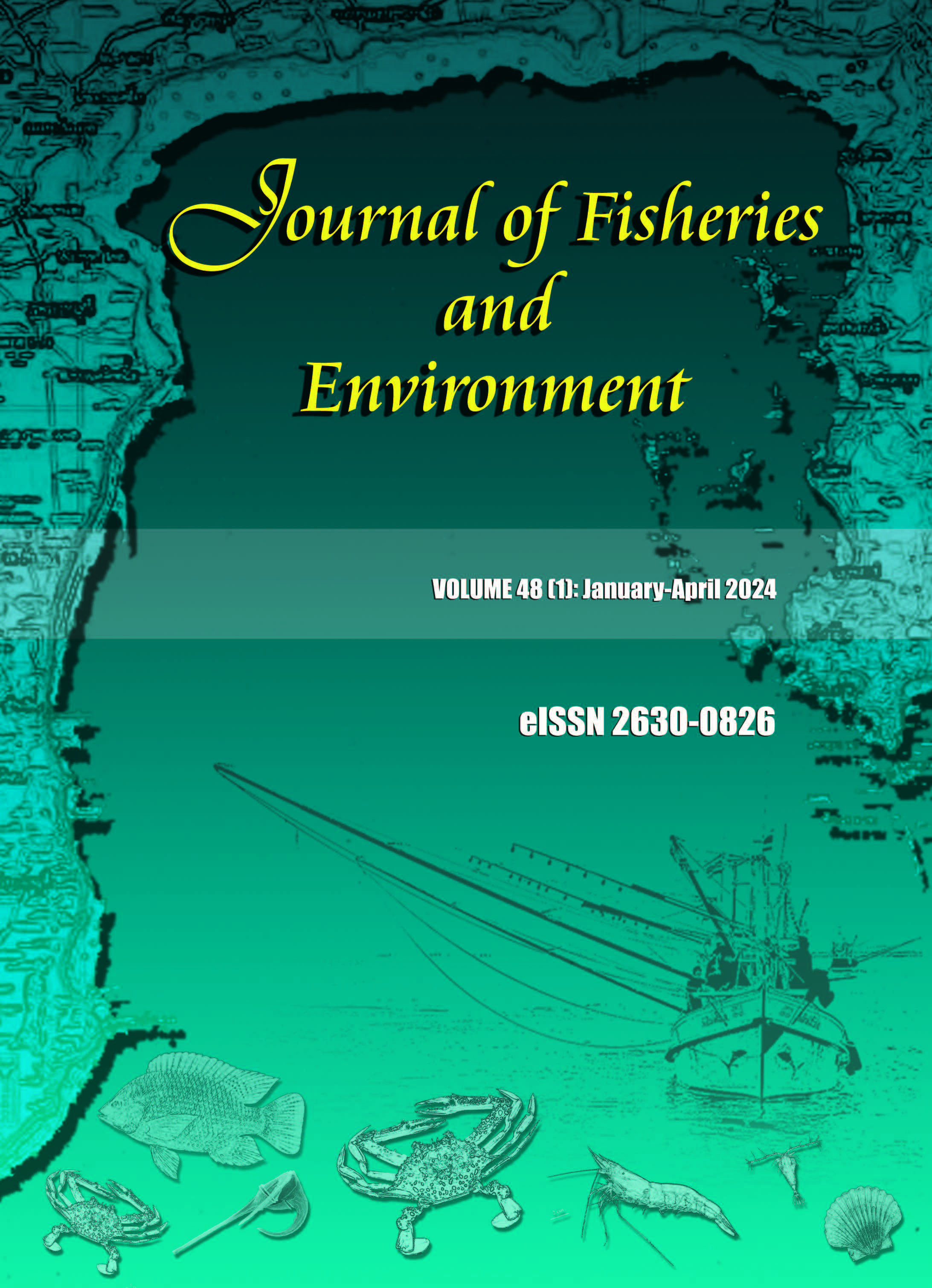Effect of Cannonball Mangrove Xylocapus granatum Koeing Bark Extract on Wound Healing in Siamese Fighting Fish (Betta splendens)
Main Article Content
Abstract
Presently, there is significant exploration of natural products as alternatives to chemical drugs, with the goal of mitigating adverse environmental impacts. This study investigates the wound-healing potential of Xylocarpus granatum bark extract in Siamese fighting fish, Betta splendens, a popular ornamental fish. The extract was prepared using the decoction method. Subsequently, the obtained extract was applied at concentrations of 60, 120, and 180 ppm to treat wounds in betta fish. These treatment groups were compared to a positive control group receiving 15 ppm oxytetracycline and a negative control group receiving no treatment over a 21-day period. The results revealed the fastest healing among groups treated with either 60 or 120 ppm of X. granatum bark extract. However, the 60 ppm concentration appeared more promising due to the highest survival rate (85.0±4.3%) among treated fish. Notably, neither the negative control nor positive control groups achieved complete wound healing within 21 days, and these groups had among the lowest survival rates. Regarding the healing effects on various tissue layers, muscle tissue healing was slower in the 60 ppm group compared to the 120 and 180 ppm groups. However, for connective tissue, dermis, epidermis and scale tissues, the 60 ppm treatment group demonstrated the fastest wound healing rates. Based on these findings, X. granatum bark extract shows potential as an effective wound healing agent for B. splendens, particularly at a concentration of 60 ppm. This natural product could offer benefits for the aquaculture industry and ornamental fish enthusiasts while mitigating environmental impacts.
Article Details

This work is licensed under a Creative Commons Attribution-NonCommercial-NoDerivatives 4.0 International License.
References
Alam, M.N., G.U. Ahmed and M.B.R. Chowdhury. 2014. Performance of herbal extracts on diseased fish. Bangladesh Journal of Veterinary Medicine 12(2): 225–230.
Boonma, T., P. Ponza and W. Khunjaroenrak. 2021. Use of Aloe vera extract for wound healing in hybrid walking catfish (Clarias macrocephalus x Clarias gariepinus). Naresuan Agriculture Journal 17(2): e0170204. (in Thai)
Chanmanee, S. 2020. Effects of Hopea odorata seeds crude extraction on treating wounds of Siamese fighting fish (Betta splendens). Journal of Vocational Institute of Agriculture 4(1): 50–55. (in Thai)
Chitmanat, C. 2013. Effects of herbal products on fish immunity. KKU Research Journal 18(21): 257–269. (in Thai)
Chitmanat, C., K. Tongdonmuan and W. Nunsong. 2005. The use of crude extracts from traditional medicinal plants to eliminate Trichodina sp. in tilapia (Oreochromis niloticus) fingerlings. Songklanakarin Journal of Science and Technology 27(Suppl 1): 359–364.
Chung, K.T., Z. Lu and M.W. Chou. 1998. Mechanism of inhibition of tannic acid and related compounds on the growth of intestinal bacteria. Food and Chemical Toxicology 36(12): 1053–1060.
Fish inspection Suvarnabhumi. 2021. Statistics on The Import and Export of Aquatic Animals at Suvarnabhumi Airport in January 2021. Fish Inspection Suvarnabhumi, Samut Prakan, Thailand. 24 pp. (in Thai)
Harikrishnan, R., C. Balasundaram and M.S. Heo. 2011. Impact of plant products on innate and adaptive immune system of cultured finfish and shellfish. Aquaculture 317(1–4): 1–15.
Julinta, R.B., T.J. Abraham, A. Roy, J. Singha, G. Dash, P. Mali, T.S. Nagesh, T.K. Sar, P.K. Patil and K.A. Kumar. 2019. Effect of oxytetracycline-dosing on the growth, safety and intestinal histology of Nile tilapia, Oreochromis niloticus (L.) juveniles. International Journal of Current Microbiology and Applied Sciences 8(8): 2708–2724.
Kajitkham, P. 2000. Introducing new breeds for market consumption. Fancy Fish 1: 76–78. (in Thai)
Koeypudsa, W., A. Ponpornpisit and N. Paphavasit. 2007. Efficacy of tropical almond
leaves (Terminalia catappa) immersed water on bacterial infection of
Siamese fighting fish (Betta splendens) and guppy (Poecillia reticulata).
Thai Fisheries Gazette 60(6): 528–533. (in Thai)
Neelapong, W., B. Phonyotin and W. Sittikijyothin. 2019. Extraction of active compounds from Thai herbs: Powder and extract. The Journal of KMUTNB 29(1): 157–166. (in Thai)
Pimolrat, P., N. Whangchai, S. Suwanpakdee and P. Sriyasak. 2017. Documentary for Training: Tannin Extract from Tropical Almond Leaf - Preparation Method and Application in Ornamental Fish. Maejo University, Chumphon, Thailand. 22 pp. (in Thai)
Polyium, U. 2018. The Extraction and Biological Activity of Taboon. Faculty of Science and Technology Rajamangala University of Technology Phra Nakhon Research Report, Bangkok, Thailand. 34 pp. (in Thai)
Puttamat, S. and W. Suwannasarn. 2007. Study of chemical composition of dried leaves of Indian almond (Terminalia catappa L.) and its effect on water quality and anti aquatic bacteria activity. Proceedings of 45th Kasetsart University Annual Conference: Plants Section 2007: 579–585. (in Thai)
Reverter, M., N. Bontemps, D. Lecchini, B. Banaigs and P. Sasal. 2014. Use of plant extracts in fish aquaculture as an alternative to chemotherapy: current status and future perspectives. Aquaculture 433: 50–61.
Rodloi, A. 2011. Standards for Ornamental Betta Fish in Thailand. Aquatic Plant and Ornamental Fish Research Group, Bangkok, Thailand. 84 pp. (in Thai)
Santoso, U., M.C. Lee and F.H. Nan. 2013. Effects of dietary katuk leaf extract on growth performance, feeding behavior and water quality of grouper Epinephelus coioides. Aceh International Journal of Science and Technology 2(1): 17–25.
Saptiani, G., A.S. Sidik and F. Ardhani. 2019. Antimicrobial of Nyirih (Xylocarpus Granatum) against pathogens of tiger shrimp post-larvae. F1000Research 8: 63. DOI: 10.12688/f1000research.16653.1.
Scalbert, A. 1991. Antimicrobial properties of tannins. Phytochemistry 30(12): 3875–3883.
Sermwatanakul, A. 2018. Developing of Siamese fighting fish (Betta splendens) to Thai national aquatic animal. E-Thai Fisheries Gazette 1(1): 160–198. (in Thai)
Somjai, D., O. Pansue and S. Chiayvareesajja. 2008. Toxicity and efficacy of clove oil for anesthetizing Siamese fighting fish (Betta splendens). Thaksin University Journal 11(2): 31–38. (in Thai)
Yoswaty, D., I. Nurrachmi, I. Effendi and E. Gabariel. 2021. Antibacterial screening on
Xylocarpus grastrnatum extract against fish pathogenic bacteria. IOP
Conference Series: Earth and Environmental Science 695(1): 012045. DOI:
1088/1755-1315/695/1/012045.


